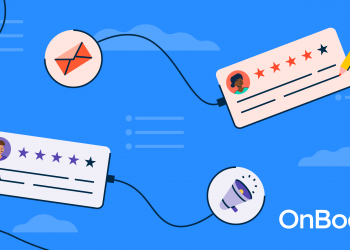Almost every single day, you interact with data (even if you don’t realize it!).
Each time we interact with technology, say your phone or a credit card, data is generated. Sometimes this data goes nowhere, but often, companies are storing and analyzing this data to build a stronger understanding of behavior.
Frankly, due to the abundance of raw data created, organizations are scrambling to understand the best ways to deploy it and use it to make better business decisions and find stronger assumptions, increasing businesses’ accuracy and effectiveness in a number of arenas. There are problems that were unsolvable in the past that can now be investigated, explored, and solved based on the types of data being created every day by social, personal, and business interactions.
What is data as a service?
This exponential creation of data from technology birthed a whole category of business service, called data as a service (DaaS).
Data users not only realized that data needed to be created with more efficiency, but it also needed to be tracked, stored, analyzed, manipulated, shared, and sold. The existence of this much data has demanded greater infrastructure to maximize the potential of data.
At its core, the DaaS industry aims to provide and distribute data through a network. Usually, data will be stored in data warehouses and made available to users through cloud computing. DaaS is a service growing exponentially due to its ability to increase ease of use and speed of access to businesses.
Given their newness, DaaS businesses price their data offerings in a variety of ways, but the most common now is volume-based pricing, which ultimately prices data depending on the megabyte size of the desired datasets used and delivered.
However, costs tend to vary depending on what type of data a business uses, how often they need to access it, and what they hope to achieve with it.
Tip: Some notable examples of DaaS providers can be found on this list.
Use cases for data in different industries
Data has always played a role in business (think of an accounting ledger tracked by hand!). But today, with the sophistication of data, we see every industry fostering data that serves their needs uniquely. Even when the same data can be used by two different parties, it can be used for vastly different reasons, and therefore, stored and manipulated uniquely, as well.
For example, we have the supply chain and logistics industry using all sorts of data metrics on their transportation methods to overcome bottlenecks. In contrast, the marketing industry might use demographic and firmographic data to create the perfect outreach methods.
“Early movers are gaining an advantage by being smart about harvesting and leveraging that data. So the rest of the industry is trying to keep up /catch up.”
– Felipe Torres, Account Executive, Investors Solutions at G2
One industry that sits in the center of DaaS is investment management. These organizations the ones writing the checks to fuel the exponential growth in the DaaS software sector, and investors are beginning to foster and build their own data systems to ensure their investments are truly the best use of funds with the highest return to their investors.
“It’s a very competitive investing landscape and you need data insights to find better companies, build more conviction, and help their companies through data.”
– Sean Saint, Head of Investor Solutions at G2
In this article, we’ll be digging into a population called institutional investors. By definition, these organizations invest money on clients’ behalf – think hedge funds, private equity investors, venture capital, and investment banks.
A significant amount of capital circulates through these markets, and historically, the decisions made by these parties mostly relied on financial data and human-to-human interactions. But as expectations and check sizes have expanded, so has the need to be absolutely confident in every investment selected.
Days of gut feeling are no longer here (though any good investor will likely tell you that intuition still matters). Instead, the prevalence of alternative data sources has dominated this market.
Traditional data vs. alternative data
Data in the investment world can be divided into two categories: traditional and alternative data.
Traditional data entails data sources such as Securities and Exchange Commission (SEC) filings, financial statements, press releases, forecasts, and much more. With this data, investors can analyze crucial financial information about a company like revenue, profitability, assets, risk factors, and financial ratios.
Traditional data is critical to making an investment decision. However, this type of data is not always available, especially in the case of private companies. Greater, in the SaaS investing space, this financial data may not even exist. Companies less than 365 days old are looking for seed money before their EBITDA is even a number.
Ultimately, traditional information is insufficient to make the best and most informed investment decision. For this reason, the most cutting-edge investors are including alternative data sources in their analyses.
Alternative data can be classified as data that is derived from non-traditional sources. Any information that can be gathered in an organized manner and prove its value in data analysis can be classified as alternative data. Some examples of alternative data include credit card transactions, mobile service, weather, review, web traffic, social media, geolocation data, and much more.
Colloquially, many think about alt data being the data created as a by-product of a business process that wasn’t designed to serve the purpose that the alternative data then serves. Alternative data has proven to be extremely relevant for investors, as it can bring forward a competitive edge for those who have access.
How to create the perfect combination of data sources
Institutional investors can be very different from one another. Each firm has different methods and resources, which ultimately depend heavily on the investment mandate and budget of each firm. The only thing all firms have in common is the fact that they are seeking above-average returns on their investment.
When seeking alpha on an investment, analysts search for potential investment targets who appear to have unique qualities, which will make them above-average performers. Ideally, they use data to build, support, and disprove hypotheses on the future success of an organization. The better their data, the more accurate their hypotheses can be. Their ability to accurately model the future financial success of an organization can be the difference of millions of dollars.
As such, they are seeking data to help with the following activities:
- Identify targets based on a variety of investing preferences
- Understand the characteristics of each to organize and prioritize which to engage
- Illuminate strengths and weaknesses of each target
- Build stronger understanding about the unique factors in each software category
These metrics may include things like year-to-date (YTD) revenue, current customer base, profit growth potential, company headcount, customer satisfaction, and growth potential. To find all this necessary information about a company, investors must use the data sources that can be quickly digested and organized.
That said, they are working against a budget and most investors prioritize having quality data sources instead of having a great quantity of datasets. Ultimately, their goal is to gain enough data to answer the questions they have about each potential investment without duplicating the types of data they have access to (which would be making the spending redundant).
Tip: Even though there is no perfect formula for data, some data sources are more popular than others in investing. When using the same data sources as other investors, a common misconception is that all investors would see the same insights from a shared data set.
However, investment mandates can vary which allows for unique outcomes and different hypotheses supported from a single data set, ultimately providing an edge to multiple organizations in a unique fashion.
In most cases, a balanced combination will include traditional and alternative data providers. Most investors know how to find more traditional datasets, given that the industry surrounding these data types is mature, but questions arise deciding on alternative data providers because this data type can have a varied definition and come in many forms.
4 types of alternative data
At G2, we look at investor alternative data as four distinct categories: internal data, people data, company data, and product data. In our estimates, the most successful investors have access to all four types – and better, they combine these alternative data sets to create powerful conclusions.
1. Internal data
Internal data is a type of data every investor generates by conducting their business affairs, such as conversations, meetings with peers, sessions with founders, and past deal cycles. This type of data is usually stored in CRM software, like Affinity, Salesforce, or any other system to organize notes and general sentiment.
For instance, let’s say an investor decides to have a coffee chat with an exciting emerging startup. During this meeting, the investor discovers some unique information, like the fact that the startup plans to hire five new software engineers to build a new product. After the meeting, the investor annotates the things discussed in the meeting in the company’s CRM.
Usually, this will not be available to the public, but it can have value for investors considering an investment in this startup, as it could be seen as an indicator of growth for a startup.
Even though internal data is not the shiniest – or cleanest – data type, it is the most common data set given its widespread accessibility and low cost (and often free)!
Human relationships are the key to business processes. Meeting founders and collaborating with employees at a potential target can be incredibly fruitful during the diligence process to understand culture and mission fit. While of course, internal data can be risky, because people’s opinions can be so subjective, the operational success of any investment will require human connection, which makes internal data the first step in building that foundation.
Software that houses internal data:
2. People data
People data offers insight into who works at a company. Most commonly known sources for people data are LinkedIn and Glassdoor.
This type of data refers to company headcount, key hires, retention rates, available job opportunities, company culture, etc. The headcount can be a key indicator that a company is growing in the case of a positive delta, or a sign that the company may have reached its full growth potential in the case of a negative delta.
Key hires can also be highly impactful. Usually, when a company brings an industry veteran, it can be a great indicator that expertise is joining the roundtable. Available job opportunities can give you a quick insight into different directions a company might be heading towards. Finally, retention rates can give you a unique insight into the company culture and if employees like the current leadership.
“Headcount growth in non-technical roles is incredible insight into how a company is performing. If they have significant Operations hiring, they are clearly selling a lot. Lots of marketing hires, their sales team is struggling to find a P/M fit. Lots of technical hires, the product isn’t GTM ready.”
– Claire McCarthy, Customer Success Manager, Investor Solutions at G2
Ultimately, needing to grow usually indicates an expanding customer base, and an expanding customer base means more revenue. Given their focus on return, this is important to investors.
3. Company data
Company data gives investors access to financial information (including that beyond the balance sheet). This type of data includes current valuations, estimated revenue, shareholder information, funding rounds, and existing investor cohort. Company data skews away from traditional financial data, because it is offered on all businesses, public or private.
Additionally, company data is collected differently from conventional financial data. For example, Crunchbase or Pitchbook relly multiple channels to retrieve data using publicly available sources and various data partners to provide investors with unique financial data.
Company data is key to investors for three key reasons: first, qualifying investment targets within investment mandate (if a company has too much or too little funding); second, existing perception of a company’s value (valuation and revenue data to understand ROI potential); and finally, understanding who your future business partners could be (getting a sense of past investors).
4. Product data
Product data refers to companies’ specific products and their relationships with customers of each product. This type of data helps investors understand how the customers of the prospective target actually like and use the product. Product data can include information like NPS scores, customer sentiment, churn data, pricing information, quality of support, and ease of use, to name a few.
This type of data is essential when analyzing an investment opportunity, the main reason being that a company can have a good financial performance and strong leadership, but at the end of the day, the ones who dictate the company’s future revenue are its customers.
Even if things look great in the short term, a product could lack must-have features or be customers to competitors, which would indicate a long-term red flag. A common way to get product data is through expert calls. This method will put you face to face with an industry expert who can give you valuable information about their experience with the product, either as an employee or as a customer.
However, expert calls often provide narrow and inconsistent data that doesn’t allow competitors to be viewed equally and can end up highly biased with oranges being compared to apples (and at an extremely high cost). To avoid this bias and strengthen understanding, many investors will increase the number of calls hosted, meaning more time and higher cost.
Moreover, this has led to investors turning to platforms and resources originally built for software buyers and using them to judge customer sentiment and software targets’ market standing, such as G2.
However, with the advent of DaaS, G2 has now developed an offering to more squarely fit into the category of product alternative data: Investor Solutions.
What is G2 Investor Solutions?
G2.com is a leader in the software peer review space, with 60M+ buyers visiting each year and leaving reviews on 158K+ products across 2,100+ software categories. All of these visits have generated an inflow of 1.8M+ reviews to date.
86%
of software buyers across segments use peer review sites to buy software.
Source: G2
While G2 was not created for investors, its data surely fits their needs. The reviews generated on G2.com produce data that helps investors spot trends, patterns, and valuable information like how happy software users are with their tech stack, what products are up and coming, what price users pay for access, NPS ratings, and much more information than what is publicly available on G2.com.
“Reviews are all the questions investors ask on expert calls, and buyer intent is one of the only datasets out there that can demonstrate how a product is performing before they’ve actually gone to market. Even if they don’t have reviews but people are going to their G2 page, that is significant information for our investors.”
– Claire McCarthy, Customer Success Manager, Investor Solutions at G2
In addition to offering information on par with what you may learn on an expert call, Investors Solutions also delivers buyer intent data, which includes traffic visits and patterns across G2.com to provide insight on what in-market software buyers are looking at.
“We mainly shine a light on the products of private companies. When a company is public, they’re required to disclose a ton of information – but private ones don’t. As a result, our data is hard to get and there aren’t too many others!”
– Felipe Torres, Account Executive, Investors Solutions at G2
Using these data sets, customers can automate sourcing and diligence workflows to make rapid sentiment analysis on the over 125k+ products listed on G2, alongside their insights from internal, company, and financial data. This continuous inflow of product data allows faster action and strong prioritization, creating an edge for users.
Example metrics from G2 Investor Solutions platform:
- TripActions has an NPS of 93 (n = 4,255) – well above the Category average of 77 and above SAP Concur (NPS = 52; n = 5,490) and TravelPerk (NPS = 92; n = 1,285).
- TripActions traffic on our site has grown 139% QoQ and 122% YoY, compared to competitor Egencia’s 114% QoQ and 103% YoY growth.
- Favorite features for this verified user: “TripActions is incredibly user-friendly and easy to navigate. The HRIS & ERP integration is used daily by my employees. TripActions support is also agile and moves with us, unlike our last tool, which left us to dry whenever we had issues.”
What’s next for data?
In the future, the use of B2B software data will be more automated. There are so many data fields that could be used as predictive triggers, and today, the data science resources are limited at most investment shops which makes this level of automation difficult. I think we’ll see a big change in the coming years. Large-scale automation will become more normalized and accessible due to demand and the competition to uncover the best businesses.
So much alternative data replaces human conversations which are time-consuming. Those won’t go away but you’ll maybe be able to have fewer or be more intentional about who you talk to based on alternative data insights.
I also think the secondary importance is finding patterns and trends. Backtesting many data sources, as compared to IPOs and fundraising of hot companies, can help firms pick up on what patterns to look for in the future to ensure they are proactively seeking those companies accordingly.
If you’re a SaaS investor and want to get a few data points on a prospective company, reach out to our team!
This article was co-written by G2’s Investor Solutions intern Lucas Masoero.
Source by learn.g2.com











